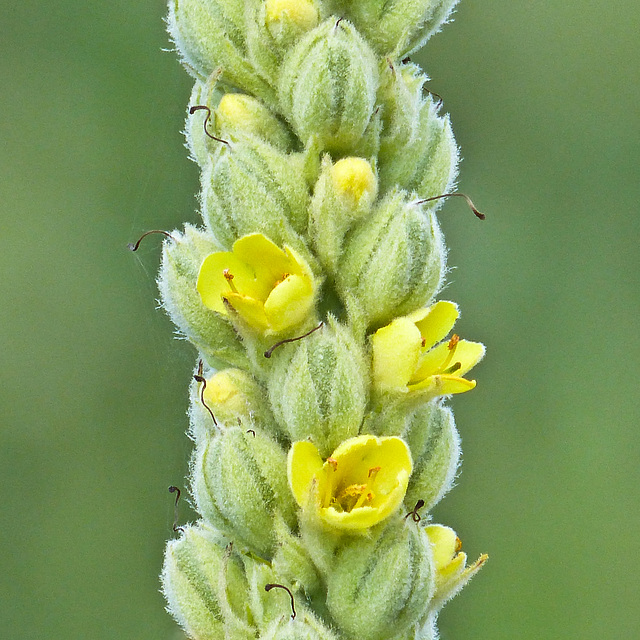Rare Narrowleaf Four-o'clock / Mirabilis linearis
Purple Prairie-clover
Prairie Coneflower
White Prairie-clover
Horseshoe Canyon, Alberta
Gumweed
Evening Primrose
Mountain Death-camas
Dotted Blazingstar / Liatris punctata
Prickly Lettuce / Lactuca serriola
Native Sunflower sp.
Love those Alberta Badlands
Glowing Sowthistle
Beynon Ecological Preserve
Beynon Ecological Preserve
See also...
Keywords
Authorizations, license
-
Visible by: Everyone -
All rights reserved
-
354 visits
Common or Great Mullein / Verbascum thapsus


Mullein growing wild at the Beynon Ecological Preserve, SW of Drumheller, in Alberta Badland country. On 3 August 2013, a group of us drove out east of Calgary to visit and record all flora and fauna found on the Beynon Ecological Preserve. This land belongs to the Nature Conservancy of Canada. One of the plants we found was this tall Mullein, growing not far from the abandoned railway tracks at the beginning of our hike. Common/Great Mullein is a noxious weed, and uncommon here.
"It is a hairy biennial plant that can grow to 2 metres tall or more. Its small yellow flowers are densely grouped on a tall stem, which bolts from a large rosette of leaves. It grows in a wide variety of habitats, but prefers well-lit disturbed soils, where it can appear soon after the ground receives light, from long-lived seeds that persist in the soil seed bank. It is a common weedy plant that spreads by prolifically producing seeds, but rarely becomes aggressively invasive, since its seeds require open ground to germinate. It is a very minor problem for most agricultural crops, since it is not a very competitive species, being intolerant of shade from other plants and unable to survive tilling. It also hosts many insects, some of which can be harmful to other plants. Although individuals are easy to remove by hand, populations are difficult to eliminate permanently.
It is widely used for herbal remedies with emollient and astringent properties. It is known to possess anti-inflammatory, anti-tumour, antiviral, antifungal, antibacterial, expectorant, and analgesic properties. It is especially recommended for coughs and related problems, but also used in topical applications against a variety of skin problems. The plant was also used to make dyes and torches." From Wikipedia.
en.wikipedia.org/wiki/Verbascum_thapsus
"Beynon is primarily a private 500+ acre ecological preserve. Located within a deeply sculpted portion of the Rosebud River valley, the area is recognized as being regionally significant. Due to its unique topography, picturesque valley setting, and relative rarity in terms of biodiversity, Beynon protected its surrounding area by permanently protecting over 400 acres (1.6 km2) from development. This protection was achieved by way of an outright donation of land by Beynon's founding family, who still own most of the unincorporated area called Beynon. The Nature Conservancy of Canada were the recipients of the 400-acre (1.6 km2) land donation in 1999." From Wikipedia.
By the way, the Beynon Canyon was featured in the cemetery scene from the 1978 film Superman: The Movie.
en.wikipedia.org/wiki/Beynon,_Alberta
"It is a hairy biennial plant that can grow to 2 metres tall or more. Its small yellow flowers are densely grouped on a tall stem, which bolts from a large rosette of leaves. It grows in a wide variety of habitats, but prefers well-lit disturbed soils, where it can appear soon after the ground receives light, from long-lived seeds that persist in the soil seed bank. It is a common weedy plant that spreads by prolifically producing seeds, but rarely becomes aggressively invasive, since its seeds require open ground to germinate. It is a very minor problem for most agricultural crops, since it is not a very competitive species, being intolerant of shade from other plants and unable to survive tilling. It also hosts many insects, some of which can be harmful to other plants. Although individuals are easy to remove by hand, populations are difficult to eliminate permanently.
It is widely used for herbal remedies with emollient and astringent properties. It is known to possess anti-inflammatory, anti-tumour, antiviral, antifungal, antibacterial, expectorant, and analgesic properties. It is especially recommended for coughs and related problems, but also used in topical applications against a variety of skin problems. The plant was also used to make dyes and torches." From Wikipedia.
en.wikipedia.org/wiki/Verbascum_thapsus
"Beynon is primarily a private 500+ acre ecological preserve. Located within a deeply sculpted portion of the Rosebud River valley, the area is recognized as being regionally significant. Due to its unique topography, picturesque valley setting, and relative rarity in terms of biodiversity, Beynon protected its surrounding area by permanently protecting over 400 acres (1.6 km2) from development. This protection was achieved by way of an outright donation of land by Beynon's founding family, who still own most of the unincorporated area called Beynon. The Nature Conservancy of Canada were the recipients of the 400-acre (1.6 km2) land donation in 1999." From Wikipedia.
By the way, the Beynon Canyon was featured in the cemetery scene from the 1978 film Superman: The Movie.
en.wikipedia.org/wiki/Beynon,_Alberta
Puzzler4879, LeapFrog have particularly liked this photo
- Keyboard shortcuts:
Jump to top
RSS feed- Latest comments - Subscribe to the comment feeds of this photo
- ipernity © 2007-2024
- Help & Contact
|
Club news
|
About ipernity
|
History |
ipernity Club & Prices |
Guide of good conduct
Donate | Group guidelines | Privacy policy | Terms of use | Statutes | In memoria -
Facebook
Twitter

Well Done!!
Seen in
Leap's Photo
Pond!!
Seen in
Leap's Photo
Pond!!
Sign-in to write a comment.